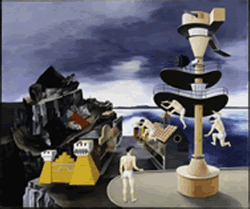Peter Blume (1906- 1992)
Painter of Dreamlike Narratives

By ROBERTA SMITH
Published: December 1, 1992
Peter Blume, a Russian immigrant whose dreamlike, obsessively detailed images made him one of this country's best-known painters in the 1930's and 40's, died yesterday at the Candlewood Nursing Home in New Milford, Conn. He was 86 years old and lived in Sherman, Conn.
He died of a stroke after a long illness, said Robert Cowley, a family friend.
Mr. Blume was born on Oct. 27, 1906, in Smorgon, a small town in the western part of White Russia and came to the United States with his family at age 5. By age 15 he was enrolled in the Educational Alliance on East Broadway in Manhattan, and by age 18 he had his own studio.
Mr. Blume was a masterful draftsman and a skillful builder of pictorial compositions, with a penchant for epic narratives and humanist themes. His artistic style was a curious hybrid of American and European traditions that combined such disparate influences as folk art and Precisionism with aspects of Parisian Purism and Cubism and, later, Surrealism.
He was catapulted to fame in 1934, when "South of Scranton," from 1931, won first prize at the Carnegie International Exhibition in Pittsburgh. The work's varied and suggestive landscape was inspired by a trip across Pennsylvania in an old car whose frequent need for repairs gave the artist a lot of time to contemplate the changing scene.
When Mr. Blume's next major painting, "The Eternal City," which took three years, was exhibited at the Julian Levy Galleries in Manhattan in 1937. By then, both the world and Mr. Blume's style had changed considerably. In this nightmarish work, the protagonist is Mussolini, who appears in the work's lower right corner as a ghoulish green jack-in-the-box; the style is more Surrealist, with the ruined city surrounding the head depicted in a state of organic, almost fleshlike decay and detail.
He is survived by his wife, Grace Douglas (Ebie) Blume, whom he married in 1931, and a sister, Beatrice Eisenberg of New York City.
Photos: Peter Blume and his 1937 painting "The Eternal City," which included Mussolini as a protagonist. (The Museum of Modern Art; 1951)